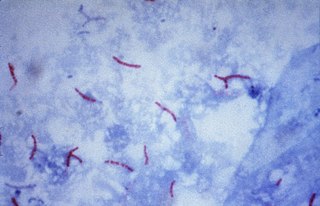
Drug resistance is the reduction in effectiveness of a medication such as an antimicrobial or an antineoplastic in treating a disease or condition. The term is used in the context of resistance that pathogens or cancers have "acquired", that is, resistance has evolved. Antimicrobial resistance and antineoplastic resistance challenge clinical care and drive research. When an organism is resistant to more than one drug, it is said to be multidrug-resistant.

P-glycoprotein 1 also known as multidrug resistance protein 1 (MDR1) or ATP-binding cassette sub-family B member 1 (ABCB1) or cluster of differentiation 243 (CD243) is an important protein of the cell membrane that pumps many foreign substances out of cells. More formally, it is an ATP-dependent efflux pump with broad substrate specificity. It exists in animals, fungi, and bacteria, and it likely evolved as a defense mechanism against harmful substances.
Geoffrey Chang is a professor at the University of California, San Diego's Skaggs School of Pharmacy and Pharmaceutical Sciences and Department of Pharmacology, School of Medicine. His laboratory focuses on the structural biology of integral membrane proteins, particularly exploring X-ray crystallography techniques for solving the tertiary structures of membrane proteins that are notoriously resistant to crystallization. The laboratory has specialized in structures of multidrug resistance transporter proteins in bacteria. In 2001, while a faculty member of The Scripps Research Institute, Chang was awarded a Beckman Young Investigators Award, designed to support researchers early in their academic careers, for his work on the structural biology of multidrug resistance. Chang announced a move from Scripps to neighboring UC San Diego in 2012.

ATP-binding cassette sub-family C member 4 (ABCC4), also known as the multidrug resistance-associated protein 4 (MRP4) or multi-specific organic anion transporter B (MOAT-B), is a protein that in humans is encoded by the ABCC4 gene.

Multidrug-resistant tuberculosis (MDR-TB) is a form of tuberculosis (TB) infection caused by bacteria that are resistant to treatment with at least two of the most powerful first-line anti-TB medications (drugs): isoniazid and rifampin. Some forms of TB are also resistant to second-line medications, and are called extensively drug-resistant TB (XDR-TB).

Multidrug resistance-associated protein 1 (MRP1) is a protein that in humans is encoded by the ABCC1 gene.

Multidrug resistance-associated protein 2 (MRP2) also called canalicular multispecific organic anion transporter 1 (cMOAT) or ATP-binding cassette sub-family C member 2 (ABCC2) is a protein that in humans is encoded by the ABCC2 gene.

Major vault protein is a protein that in humans is encoded by the MVP gene. 78 copies of the protein assemble into the large compartments called vaults.

Canalicular multispecific organic anion transporter 2 is a protein that in humans is encoded by the ABCC3 gene.

Multidrug resistance-associated protein 7 is a protein that in humans is encoded by the ABCC10 gene.

Desmosterol (Cholesta-5,24-dien-3β-ol) is a lipid present in the membrane of phytoplankton. Structurally, desmosterol has a similar backbone to cholesterol, with the exception of an additional double bond in the structure of desmosterol.

Jatrorrhizine is a protoberberine alkaloid found in some plant species, such as Enantia chlorantha (Annonaceae). Synonyms that may be encountered include jateorrhizine, neprotin, jatrochizine, jatrorhizine, and yatrorizine.

The cortistatins are a group of steroidal alkaloids first isolated in 2006 from the marine sponge Corticium simplex. The cortistatins were first discovered in a search for naturally occurring compounds that inhibit proliferation of human umbilical vein endothelial cells (HUVECs), with cortistatin A being the most potent compound in the class.

Callyspongia truncata is a species of marine sea sponge. Like all marine sponges, C. truncata is a member of phylum Porifera and is defined by its filter-feeding lifestyle and flagellated choanocytes, or collar cells, that allow for water movement and feeding. It is a species of demosponge and a member of Demospongiae, the largest class of sponges as well as the family Callyspongiidae. C. truncata is most well known for being the organism from which the polyketide Callystatin A was identified. Callystatin A is a polyketide natural product from the leptomycin family of antibiotics. It was first isolated in 1997 from this organism, which was collected from the Goto Islands in the Nagasaki Prefecture of Japan by the Kobayashi group. Recent studies have revealed numerous other bioactive compounds that have been found in this species.
Antineoplastic resistance, often used interchangeably with chemotherapy resistance, is the resistance of neoplastic (cancerous) cells, or the ability of cancer cells to survive and grow despite anti-cancer therapies. In some cases, cancers can evolve resistance to multiple drugs, called multiple drug resistance.

Oroidin is a bromopyrrole alkaloid, originally isolated from marine sponges in the genus Agelas. Its complex structure leads to wide biological activities, which makes Oroidin a potential drug candidate for various diseases. It also serves as chemical defense in marine sponges.

Lacking an immune system, protective shell, or mobility, sponges have developed an ability to synthesize a variety of unusual compounds for survival. C-nucleosides isolated from Caribbean Cryptotethya crypta, were the basis for the synthesis of zidovudine (AZT), aciclovir (Cyclovir), cytarabine (Depocyt), and cytarabine derivative gemcitabine (Gemzar).
Dysidea arenaria is a species of marine sponge (poriferan) found in the Pacific Ocean. It is a member of the order Dictyoceratida, one of two sponge orders that make up the keratose or "horny" sponges in which a mineral skeleton is absent and a skeleton of organic fibers is present instead.
In pharmacology and medicine, vectorization of drugs refers to (intracellular) targeting with plastic, noble metal or silicon nanoparticles or liposomes to which pharmacologically active substances are reversibly bound or attached by adsorption.

Branimir Ivan "Brandy" Sikic is an American medical doctor and scientist at Stanford University School of Medicine. He is an oncologist and cancer pharmacologist, and has served as a faculty member at Stanford University since 1979. His research spans basic, translational, and clinical research and investigates the mechanisms of drug resistance and the development of new anticancer therapies.
















